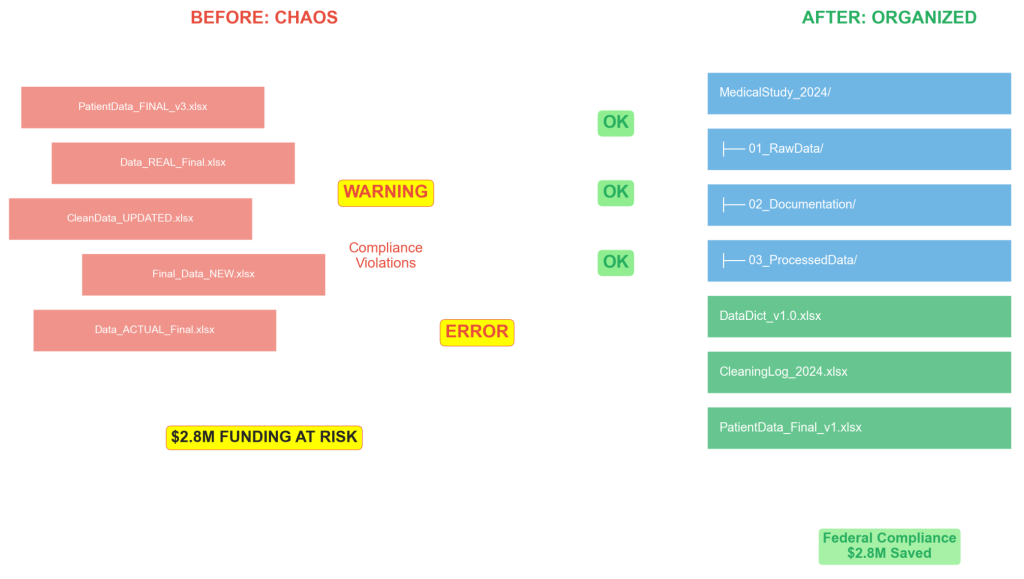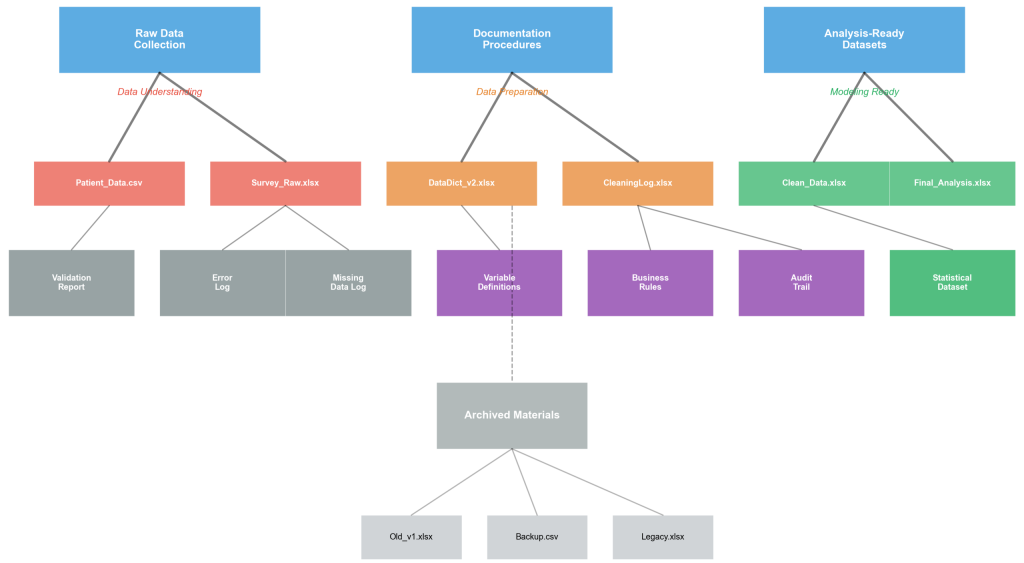Chapter 3.6: Data Organization and Reproducible Workflows
This chapter examines the systematic documentation and organizational practices that transform individual data preparation work into collaborative, reproducible processes. Key concepts include comprehensive data dictionaries, systematic audit trails, file organization systems, and collaborative workflow procedures that ensure data integrity and support long-term project success in professional environments.
The Critical Role of Documentation in Data Science
Data organization and reproducible workflows represent the foundational infrastructure that enables professional data science projects to maintain integrity, support collaboration, and meet regulatory requirements across personnel changes and organizational contexts. Unlike individual analytical work, professional data science environments require systematic documentation practices that capture not only what transformations were performed but also why decisions were made, how they can be verified, and how they support broader organizational objectives.
The Regional Medical Research Center case exemplifies the consequences of inadequate documentation practices. When Lead Data Scientist Dr. Sarah Kim departed for sabbatical, her replacement Dr. James Martinez discovered that three years of patient data cleaning work was essentially unreproducible due to insufficient documentation, threatening $2.8 million in federal funding. The crisis emerged when regulatory auditors from the Department of Health and Human Services required complete documentation of all data handling procedures to maintain research compliance under federal research integrity guidelines.

Figure 3.6.1: Transformation from chaotic documentation practices to systematic organizational frameworks at Regional Medical Research Center. The before state shows multiple conflicting file versions and missing audit trails, while the after state demonstrates organized hierarchies, clear naming conventions, and comprehensive documentation that enabled federal compliance restoration and $2.8 million funding preservation.
Professional data science requires systematic approaches that prioritize institutional knowledge preservation over individual convenience. The transformation achieved at the medical research center demonstrates how proper documentation converts individual technical work into sustainable collaborative processes that support scientific integrity while meeting regulatory compliance requirements.
Comprehensive Data Dictionaries for Professional Collaboration
Data dictionaries serve as the foundational documentation element that enables team collaboration and knowledge transfer by capturing complete information about dataset structure, content, and meaning. Unlike simple variable lists, comprehensive data dictionaries document every aspect necessary for accurate interpretation including variable names, data types, valid value ranges, business definitions, source system information, and update procedures.
Professional Data Dictionary Components: Systematic documentation using structured formats that capture variable names, data types, valid value ranges, business definitions, source system information, and documentation update dates. For categorical variables, complete explanations specify each possible value and its business significance, such as defining patient risk levels where numerical codes correspond to specific clinical interpretations requiring different intervention protocols.
The effectiveness of comprehensive data dictionaries becomes particularly evident in complex analytical environments such as healthcare research, where medical coding requires specialized interpretation that cannot be inferred from variable names alone. Dr. Martinez’s experience at the medical research center demonstrates how the absence of comprehensive documentation made it impossible for new team members to understand specialized coding that required contextual knowledge of regulatory requirements and clinical protocols.
Excel Data Dictionary Implementation: Create systematic documentation using Excel tables with standardized columns for variable names, data types, value ranges, business definitions, source systems, and update dates. Establish separate worksheets for different data categories while maintaining cross-references that enable comprehensive understanding of dataset relationships and dependencies.
According to the Data Management Association International, organizations implementing comprehensive data dictionaries achieve 60% reduction in data interpretation errors and accelerate new team member productivity by three weeks compared to informal documentation approaches (DAMA International, 2024). This improvement stems from systematic capture of institutional knowledge that would otherwise exist only in individual experience and informal communications.
Systematic Audit Trails and Decision Documentation
Systematic cleaning logs create detailed audit trails that document every data transformation decision, enabling the reproducibility and accountability that regulatory environments demand. Unlike personal notes or informal documentation, systematic audit trails capture not only what actions were performed but also why decisions were made, who authorized them, and how they can be verified or reversed if necessary.
Professional audit trails extend beyond simple action logs to include decision rationales that explain analytical justification, alignment with business requirements, and validation procedures that confirmed appropriateness. This level of documentation proved essential for maintaining the medical center’s compliance with federal research integrity standards while supporting collaborative analysis workflows that enable seamless personnel transitions.
Systematic Log Entry Structure: Excel worksheets with standardized columns recording transformation date, responsible analyst, action type, affected records, decision rationale, and reviewing authority. Complete entries document specific examples such as “March 15, 2024: Analyst J. Martinez performed outlier removal affecting 23 records by eliminating salary values exceeding $500,000 based on position title analysis, with verification by senior researcher S. Kim.”
Healthcare Compliance Impact: The Healthcare Information and Management Systems Society reports that medical research organizations implementing comprehensive audit trails reduce regulatory compliance violations by 75% while improving research reproducibility rates from 40% to 89% across multi-year studies. This improvement reflects systematic documentation requirements mandated by federal research integrity guidelines under Department of Health and Human Services oversight.
Audit trail systems scale across different organizational sizes and regulatory contexts by establishing consistent documentation standards that capture essential decision information without creating excessive administrative burden. The systematic approach enables organizations to maintain operational efficiency while meeting accountability requirements that support both internal quality assurance and external regulatory compliance.
File Organization and Version Control Systems
Systematic file organization creates structural frameworks that enable collaborative analysis through clear naming conventions, logical folder hierarchies, and version control procedures. Professional file organization prioritizes institutional knowledge preservation over individual convenience by establishing systematic approaches that remain functional across personnel changes and project transitions.

Figure 3.6.2: Professional file organization hierarchy reflecting analytical methodology phases with clear separation between data processing states. The structure demonstrates primary organizational categories corresponding to data collection, documentation procedures, processed datasets, analysis-ready files, and archived materials that prevent organizational chaos and ensure project continuity.
Hierarchical folder structures reflect analytical methodology phases while supporting clear separation between different data processing states. Primary organizational categories correspond to data collection, documentation procedures, processed datasets, analysis-ready files, and archived materials. This systematic approach prevents the organizational chaos that can render analytical work unusable when key personnel leave or project requirements change.
Professional Version Control: Standardized naming conventions that capture file evolution while preventing accidental overwrites that compromise analytical integrity. Systematic naming patterns incorporate project identification, dataset description, version numbering, processing status, and creation date using formats such as “ProjectName_DatasetType_VersionNumber_ProcessingStatus_Date.xlsx” that immediately convey essential information about file content and current status.
The medical research center’s transformation from chaotic file organization to systematic structure demonstrates how professional approaches enable organizations to maintain research quality and regulatory compliance during personnel transitions. Files with names like “PatientData_FINAL_v3_revised.xlsx” were replaced with systematic naming conventions that immediately communicated project status, data content, and processing stage.
Collaborative Workflow Design and Quality Assurance
Reproducible workflows represent the culmination of systematic documentation practices by establishing standardized procedures that ensure consistent analytical execution regardless of personnel changes. Collaborative workflow procedures integrate data dictionaries, cleaning logs, and file organization systems while incorporating role definitions, review requirements, and handoff protocols that maintain analytical integrity throughout project lifecycles.
Professional workflow design incorporates role definitions, review requirements, and handoff protocols that balance operational efficiency with accuracy verification requirements. Tiered review systems accommodate different types of analytical decisions by requiring peer verification for routine cleaning operations, subject matter expert approval for complex business rule applications, and senior researcher authorization for regulatory compliance decisions.
Quality Assurance Framework: Standardized checklists for each workflow stage include data receipt verification, cleaning procedure execution, quality assurance testing, and documentation completion requirements. These systematic approaches create accountability mechanisms that ensure analytical work meets professional standards while supporting both individual competency development and organizational capability building.
Organizational Impact: Regional Medical Research Center’s systematic workflow implementation enabled successful navigation of Department of Health and Human Services compliance requirements while maintaining $2.8 million in federal funding during significant personnel transitions. The systematic approach demonstrated how proper documentation transforms individual technical work into sustainable collaborative processes that support long-term institutional success.
Quality assurance procedures create accountability mechanisms that ensure analytical work meets professional standards while maintaining project momentum in team environments where personnel changes are common. These systematic workflows establish the foundation for advancing through different analytical tool environments while maintaining consistent professional standards that support both immediate operational requirements and long-term strategic development.
Integration with Statistical Analysis Methodology
Systematic documentation and organizational practices create foundations for advancing through different analytical tool environments while maintaining consistent professional standards. Documentation work using accessible tools like Excel establishes organizational structures necessary for transitioning to statistical software applications and automated workflow platforms while preserving collaborative capabilities and institutional knowledge.
Professional data organization supports tool progression by ensuring that analytical work maintains reproducible standards regardless of technological sophistication. Initial documentation using spreadsheet-based systems provides systematic foundations that scale effectively to advanced statistical environments while preserving the collaborative capabilities essential for team-based data science projects.
Professional Standards and Career Development: Systematic documentation practices align with Data Management Association International certification requirements and industry standards that prepare professionals for data science roles requiring collaborative workflow management capabilities. These foundational skills support career advancement while ensuring organizational knowledge preservation across different technological contexts.
This systematic approach enables organizations to maintain analytical quality and regulatory compliance while advancing technological capabilities, supporting both immediate operational requirements and long-term strategic development in data science capabilities. The organizational framework established through comprehensive documentation provides the foundation necessary for statistical analysis work that maintains the reproducible standards essential for professional data science practice.
Summary and Professional Application
Data organization and reproducible workflows transform individual data preparation work into collaborative, sustainable processes that support both analytical quality and organizational accountability. The systematic approaches examined in this chapter—comprehensive data dictionaries, audit trail documentation, file organization systems, and collaborative workflow procedures—establish the foundational infrastructure necessary for professional data science practice.
The transformation achieved at Regional Medical Research Center demonstrates how systematic documentation practices enable organizations to maintain research integrity and regulatory compliance while supporting seamless personnel transitions and collaborative analysis workflows. These organizational capabilities become increasingly critical as analytical work advances through statistical analysis phases that require clear documentation of data preparation decisions and transformation procedures.
Professional data organization provides the systematic foundation necessary for advancing to statistical analysis environments while maintaining the collaborative standards and institutional knowledge preservation that characterize mature data science capabilities. These foundational practices establish the organizational framework that supports both immediate analytical requirements and long-term strategic development in data-driven organizational contexts.

